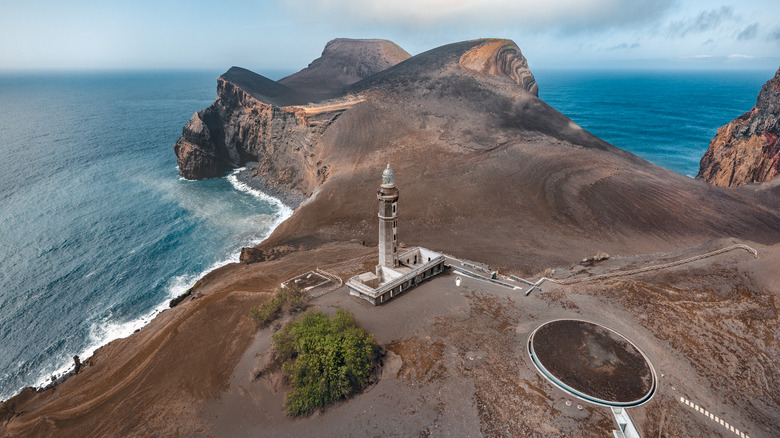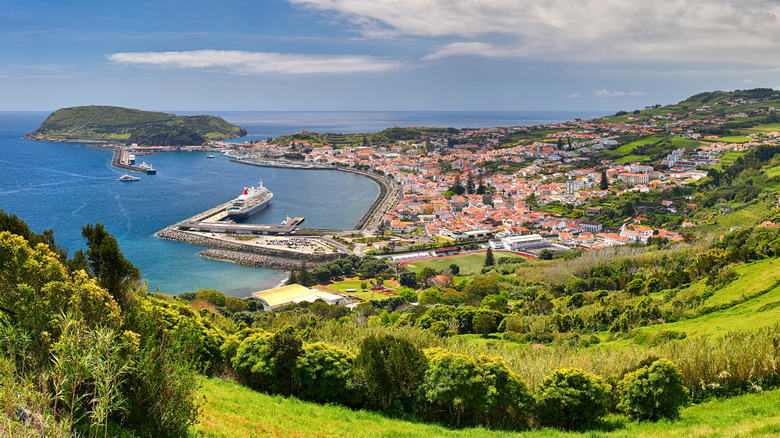The Landscape On This Portuguese Island Is Eerily Similar To Mars
The Azores islands of Portugal are known around the world for their dazzling scenery. The biggest and most famous of the nine islands, São Miguel, boasts the spectacular blue and green lakes of Sete Cidades along with glorious geothermal parks, where steaming rivers weave through luxuriant gardens. Pico has its prized volcanic vineyards as well as Portugal's tallest mountain, while Flores features breathtaking waterfalls and flower-strewn meadows. Volcanic activity helped shape these incredible landscapes, with most major eruptions in the archipelago having occurred hundreds or thousands of years ago — with one remarkable exception.
On September 27, 1957, the waters near the Capelinhos lighthouse on the northwest side of Faial — one of the middle group of islands — began frothing and bubbling. At first, whaling captain João Faria interpreted the disturbance as a school of whales moving beneath the ocean's surface. However, as putrid gases and pyroclastic material began spouting violently from the site, it became clear that a force more powerful than whales was reawakening. What transpired over the next year would dramatically transform Faial's geography and change the lives of its inhabitants forever.
The Capelinhos eruption
The nascent volcano erupted intermittently over the next 13 months, at one point spewing volcanic material 4,200 feet into the atmosphere. Ash from the eruption blanketed nearby villages, completely burying houses and farmland, while massive amounts of debris gathered in the ocean, forming a new finger of land near the destroyed lighthouse. Miraculously, no one died during the eruptions and the associated earthquakes. But the disaster destroyed homes and livelihoods on Faial and terrified everyone in the Azores region, prompting thousands to emigrate.
Today, the eruption site remains covered by reddish rock and is devoid of most vegetation, making it look eerily similar to Mars. There is a legitimate scientific reason for this: the geological events that sculpted Martian landscapes a billion years ago may have been similar to those of the forces that birthed Capelinhos. "We can see Mars on Earth through the Capelinhos volcano," said former NASA director James B. Garvin, per The Herald News. For this reason, Capelinhos has become an important location in the world for studying planetary science. Among the Azorean islands, Faial is alone in claiming that distinction.
Faial beyond the volcano
You don't have to be a scientist to appreciate a visit to Capelinhos. The area around the destroyed lighthouse is a fascinating place to explore on foot and with a camera, especially at sunset. The Capelinhos Volcano Interpretation Centre, which features pictures and video footage of the eruption along with geology and vulcanology exhibits, is also well worth a visit. The centre is open from 9 a.m. to 6 p.m. Monday through Sunday, with an admission fee of 10 euros ($11) per adult. Admission is 5 euros ($5.50) for youths between the ages of 7 and 14, and children under 7 enter free.
Beyond the volcano, there's much more to do on Faial, which is known as the blue island for its endless rows of indigo hydrangeas. Horta, the island's main population center, is one of the most vibrant cities in the archipelago. Its marina is the fourth busiest in the world, a popular stopover for sailboats making their way across the Atlantic. No visit to Horta is complete without paying tribute to Peter Cafe Sport, among the most famous sailor bars in the world. Here, seafarers from every walk of life drop by to swap stories over steamy bowls of fish soup and Peter's renowned gin and tonics, making you feel like you're at the center of the maritime universe. And on this tiny volcanic island near the geographic middle of one of the world's largest oceans, maybe you are.


